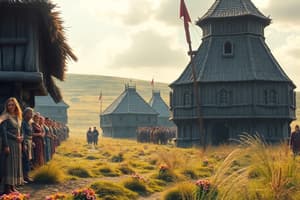Podcast
Questions and Answers
What is one possible explanation for the finds of weapons recovered from wetland areas in Denmark?
What is one possible explanation for the finds of weapons recovered from wetland areas in Denmark?
- They were everyday tools for fishing activities.
- They were primarily used in battles between tribes.
- They were offerings related to ritual acts. (correct)
- They were discarded military supplies from wars.
What type of weapon is most commonly reported among the finds at Gudingsåkrarna in Gotland?
What type of weapon is most commonly reported among the finds at Gudingsåkrarna in Gotland?
- Spearheads (correct)
- Swords
- Bows
- Axes
What is suggested as a possible purpose for miniature weapons found during archaeological excavations?
What is suggested as a possible purpose for miniature weapons found during archaeological excavations?
- To serve as training tools for young warriors.
- To symbolize wealth and status among leaders.
- To act as magical amulets against evil forces. (correct)
- To be displayed in ceremonial settings.
Which god is mentioned in association with the ritualized and symbolic use of weapons?
Which god is mentioned in association with the ritualized and symbolic use of weapons?
What indicates that some finds of weapons may be attributed to ritual deposition rather than practical use?
What indicates that some finds of weapons may be attributed to ritual deposition rather than practical use?
What is commonly used to cover the hole for the hand-grip at the center of the shield?
What is commonly used to cover the hole for the hand-grip at the center of the shield?
Which of the following colors was not mentioned as being used for shields?
Which of the following colors was not mentioned as being used for shields?
What type of helmets are indicated to have been used by Viking warriors?
What type of helmets are indicated to have been used by Viking warriors?
What material is suggested to have been an alternative to metal for helmets?
What material is suggested to have been an alternative to metal for helmets?
What type of protective armor is indicated to have been found at Birka?
What type of protective armor is indicated to have been found at Birka?
Where are complete swords and spearheads most commonly found?
Where are complete swords and spearheads most commonly found?
What type of weaponry was generally more common in settlement contexts, according to the content?
What type of weaponry was generally more common in settlement contexts, according to the content?
What suggests that chain mail shirts were expensive and exclusive?
What suggests that chain mail shirts were expensive and exclusive?
What was a central aspect of the relationship between greater and lesser kings in early medieval Britain?
What was a central aspect of the relationship between greater and lesser kings in early medieval Britain?
What does the term 'chevauchée' refer to in the context of medieval warfare?
What does the term 'chevauchée' refer to in the context of medieval warfare?
How did Charlemagne's campaigns mainly operate according to Timothy Reuter?
How did Charlemagne's campaigns mainly operate according to Timothy Reuter?
What distinguishes Viking leaders from other early medieval rulers in warfare?
What distinguishes Viking leaders from other early medieval rulers in warfare?
What is implied about the Franks' payment of tribute?
What is implied about the Franks' payment of tribute?
What can be said about the Vikings' reputation on the battlefield?
What can be said about the Vikings' reputation on the battlefield?
What strategy did the Vikings often employ during their campaigns?
What strategy did the Vikings often employ during their campaigns?
What was a characteristic of plundering warfare in medieval Europe?
What was a characteristic of plundering warfare in medieval Europe?
What distinguishes the twelve types of axe-heads identified by J. Petersen?
What distinguishes the twelve types of axe-heads identified by J. Petersen?
Which type of axe-head is thought to have been introduced from the eastern Baltic region?
Which type of axe-head is thought to have been introduced from the eastern Baltic region?
What feature is common among heavy thrusting spears from the Viking Age?
What feature is common among heavy thrusting spears from the Viking Age?
In what context were spears typically found during the Viking Age?
In what context were spears typically found during the Viking Age?
Which type of axe-head had a shape similar to those seen in the Bayeux tapestry?
Which type of axe-head had a shape similar to those seen in the Bayeux tapestry?
What material was commonly used for the shafts of Viking Age spears?
What material was commonly used for the shafts of Viking Age spears?
What is distinctive about type L spearheads from Petersen's classification?
What is distinctive about type L spearheads from Petersen's classification?
How were spearheads typically attached to their shafts in the Viking Age?
How were spearheads typically attached to their shafts in the Viking Age?
What was a primary motivation for Viking raids against western Europe?
What was a primary motivation for Viking raids against western Europe?
Which two historical Viking leaders are mentioned as using their achievements in England to assert their claims in Norway?
Which two historical Viking leaders are mentioned as using their achievements in England to assert their claims in Norway?
What form of wealth does conquest provide during the Viking Age?
What form of wealth does conquest provide during the Viking Age?
How could the Vikings obtain wealth without conquest?
How could the Vikings obtain wealth without conquest?
What is 'Danegeld' primarily associated with in Viking history?
What is 'Danegeld' primarily associated with in Viking history?
What archaeological evidence supports the occurrence of Viking looting?
What archaeological evidence supports the occurrence of Viking looting?
What is one reason why scholarly interpretations of Viking raids vary?
What is one reason why scholarly interpretations of Viking raids vary?
What did the military expansion during the Viking Age coincide with?
What did the military expansion during the Viking Age coincide with?
What was one significant observation made about Viking fleet sizes during the mid-ninth century?
What was one significant observation made about Viking fleet sizes during the mid-ninth century?
What does the presence of titles like 'king' or 'earl' among Viking leaders indicate?
What does the presence of titles like 'king' or 'earl' among Viking leaders indicate?
How did Peter Sawyer view the reported sizes of Viking fleets?
How did Peter Sawyer view the reported sizes of Viking fleets?
What was a notable argument made by Nicholas Brooks regarding fleet sizes?
What was a notable argument made by Nicholas Brooks regarding fleet sizes?
What general trend in interpretations of early medieval warfare has emerged since the mid-1980s?
What general trend in interpretations of early medieval warfare has emerged since the mid-1980s?
What suggestion did Janet Nelson make regarding Viking raids and other conflicts in the late ninth century?
What suggestion did Janet Nelson make regarding Viking raids and other conflicts in the late ninth century?
What is a conclusion that can be drawn about the achievements of the Vikings in warfare?
What is a conclusion that can be drawn about the achievements of the Vikings in warfare?
How do historians currently view the scale of Viking armies?
How do historians currently view the scale of Viking armies?
Flashcards
Motivation behind Scandinavian raids on Western Europe
Motivation behind Scandinavian raids on Western Europe
The desire to gain wealth abroad, frequently leading to the establishment of Viking kingdoms in countries like Britain, Ireland, and Normandy.
How Viking leaders used wealth to gain power in Norway
How Viking leaders used wealth to gain power in Norway
Vikings utilized their military success in England to advance their claims to the Norwegian throne.
Methods Vikings used to acquire wealth through raiding
Methods Vikings used to acquire wealth through raiding
Plunder, ransoming of captives, precious objects, and imposing tributes were common ways Vikings gained wealth.
Danegeld and its historical significance
Danegeld and its historical significance
Signup and view all the flashcards
Evidence of early Viking raids
Evidence of early Viking raids
Signup and view all the flashcards
Anglo-Saxon coins found in Scandinavia and their significance
Anglo-Saxon coins found in Scandinavia and their significance
Signup and view all the flashcards
Debates on the importance of Viking raids
Debates on the importance of Viking raids
Signup and view all the flashcards
Variations in Viking raiding patterns
Variations in Viking raiding patterns
Signup and view all the flashcards
Sacrificial Offering
Sacrificial Offering
Signup and view all the flashcards
Wetland Weapon Finds
Wetland Weapon Finds
Signup and view all the flashcards
Miniature Weapons
Miniature Weapons
Signup and view all the flashcards
Ritual Deposition of Weapons
Ritual Deposition of Weapons
Signup and view all the flashcards
Symbolic and Magical Use of Weapons
Symbolic and Magical Use of Weapons
Signup and view all the flashcards
Chevauchée
Chevauchée
Signup and view all the flashcards
Tribute
Tribute
Signup and view all the flashcards
Geld
Geld
Signup and view all the flashcards
Paradigm
Paradigm
Signup and view all the flashcards
Private Warlord
Private Warlord
Signup and view all the flashcards
Exaggerated Reputation
Exaggerated Reputation
Signup and view all the flashcards
Avoiding Battle
Avoiding Battle
Signup and view all the flashcards
Plundering for Portable Wealth
Plundering for Portable Wealth
Signup and view all the flashcards
Shield Boss
Shield Boss
Signup and view all the flashcards
Shield Rim-Binding
Shield Rim-Binding
Signup and view all the flashcards
Shield Colors
Shield Colors
Signup and view all the flashcards
Viking Helmet
Viking Helmet
Signup and view all the flashcards
Chain Mail
Chain Mail
Signup and view all the flashcards
Plate Armor
Plate Armor
Signup and view all the flashcards
Sword
Sword
Signup and view all the flashcards
Burial Weapons
Burial Weapons
Signup and view all the flashcards
Viking Fleet Growth
Viking Fleet Growth
Signup and view all the flashcards
Viking Leadership
Viking Leadership
Signup and view all the flashcards
Exaggerated Viking Fleet Numbers
Exaggerated Viking Fleet Numbers
Signup and view all the flashcards
Sawyer's Argument
Sawyer's Argument
Signup and view all the flashcards
Brooks' Counter Argument
Brooks' Counter Argument
Signup and view all the flashcards
Debate on Viking Fleet Size
Debate on Viking Fleet Size
Signup and view all the flashcards
Viking Achievements and Fleet Size
Viking Achievements and Fleet Size
Signup and view all the flashcards
Frankish Perspective on Vikings
Frankish Perspective on Vikings
Signup and view all the flashcards
Petersen's Axe-head Typology
Petersen's Axe-head Typology
Signup and view all the flashcards
Cross-Shaped Axe-Head
Cross-Shaped Axe-Head
Signup and view all the flashcards
Helmed Axe-Heads
Helmed Axe-Heads
Signup and view all the flashcards
Decorated Axe-Heads
Decorated Axe-Heads
Signup and view all the flashcards
Viking Spearheads
Viking Spearheads
Signup and view all the flashcards
Petersen's Spearhead Typology
Petersen's Spearhead Typology
Signup and view all the flashcards
Spearhead Type L
Spearhead Type L
Signup and view all the flashcards
Ash Wood for Spear Shafts
Ash Wood for Spear Shafts
Signup and view all the flashcards
Study Notes
Viking Age Raiding and Warfare
- Raiding and warfare were central to understanding the Viking Age
- Early image of Vikings was brutal warriors, terrifying, and committing atrocities
- This image has been challenged since the 1960s and 1970s
- Historical accounts written by victims likely exaggerated impact and barbarity
- "Viking" encompasses entire society, but raiding is defining activity
- Evidence of contact between Scandinavia and Europe existed before late 8th century
- Viking expansion significant from late 8th to 11th centuries
- Motivation for early raids debated; one theory is a religious response to Frankish Christian mission
- Evidence suggests primary motivation was acquiring wealth
- Raiding led to wealth (land, portable items, tribute)
- Raiding could lead to political power, both abroad and at home
Studying That Suits You
Use AI to generate personalized quizzes and flashcards to suit your learning preferences.




